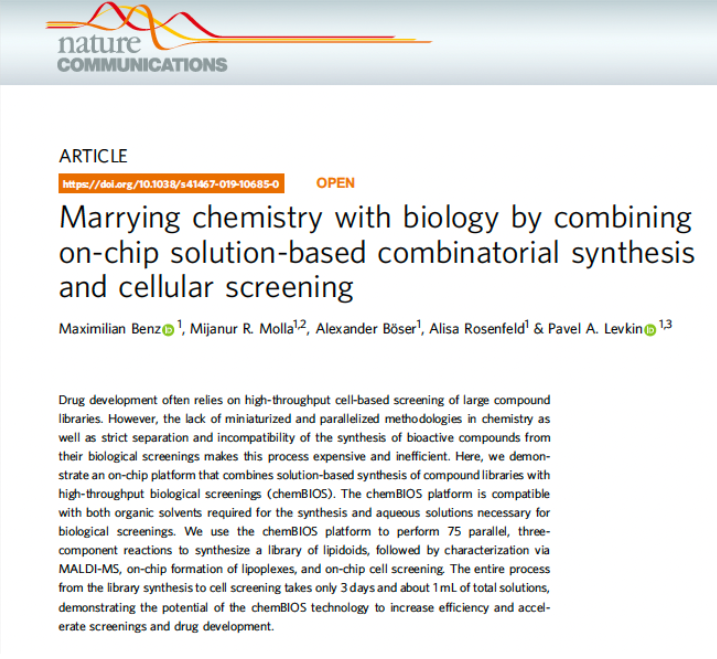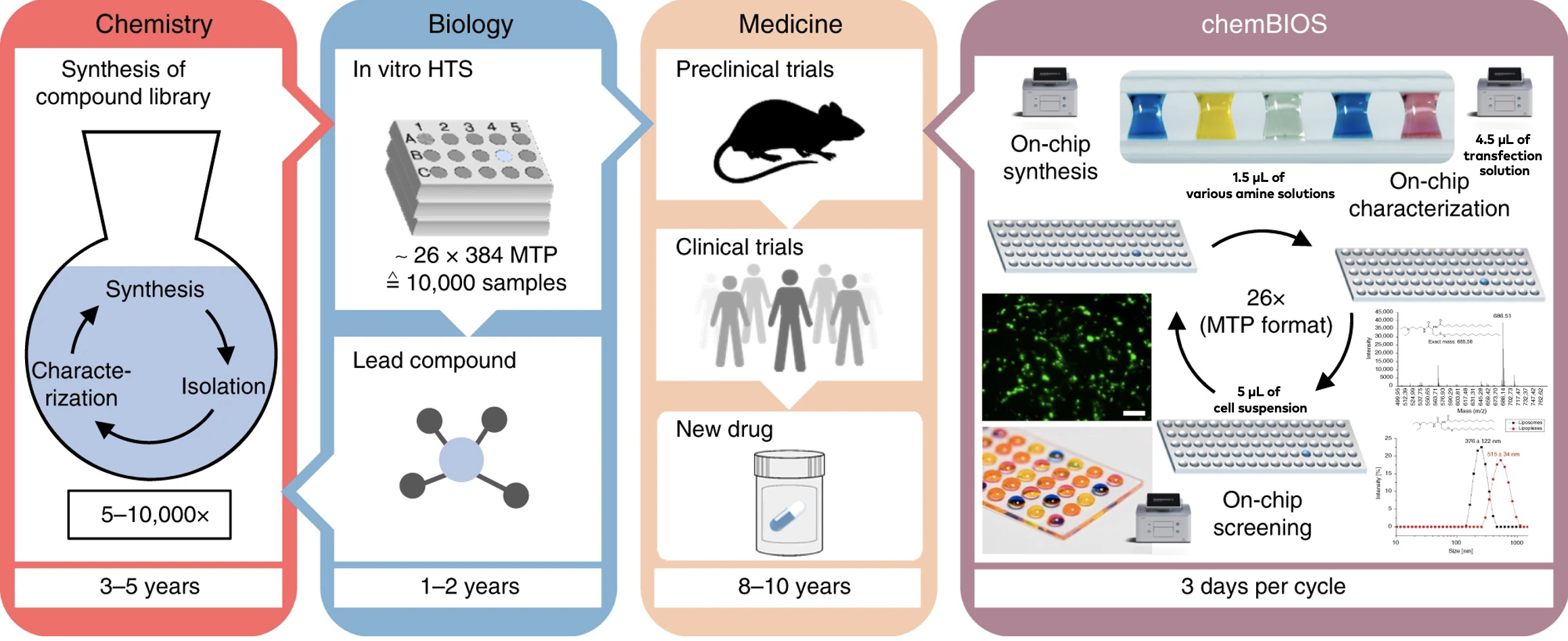The ever-growing demand for new drugs puts immense pressure on pharmaceutical companies to find ways to streamline drug development. Traditional methods are not only time-intensive but also costly, often taking years and requiring vast resources. However, innovations like DISPENDIX’s I.DOT Liquid Handler are changing the landscape of drug discovery.
The article Marrying chemistry with biology by combining on-chip solution-based combinatorial synthesis and cellular screening explores a new microarray platform called chemBIOS (Fig. 1). This platform integrates solution-based chemical synthesis and biological screening to accelerate drug development.

Figure 1. "Marrying chemistry with biology by combining on-chip solution-based combinatorial synthesis and cellular screening' published in Nature Communications.
Introducing chemBIOS
Traditional methods of synthesizing and testing drug compounds are time-consuming and inefficient, often taking years and using large volumes of solvents. The chemBIOS platform addresses this by allowing miniaturized, parallel chemical reactions and screenings, all on a single chip, significantly reducing time and resource consumption.
The authors, our customers at Karlsruhe Institute of Technology (KIT), used the chemBIOS platform to synthesize and screen a library of lipidoids (lipid-like molecules), demonstrating its potential for high-throughput drug discovery. The entire process, from synthesizing compounds to biological screening, took only three days, compared to traditional methods that would take much longer. This approach has significant implications for drug discovery and other biological research, offering a more efficient and cost-effective solution.
Challenges in Traditional Drug Development
The researchers demonstrate how miniaturization and parallelization can significantly accelerate the drug discovery process. The integration of I.DOT technology into this workflow allowed for precise and automated dispensing of reagents in droplet form, enabling the creation of a lipidoid library in a highly efficient manner.

How I.DOT Enhances chemBIOS for Drug Discovery
Synthesis and characterization of a lipidoid library
The on-chip synthesis of a lipidoid library using the printing method was achieved by dispensing 1.5 µL of various amine solutions onto each spot, column by column, on an LSTL slide A with the I.DOT Non-Contact Dispenser (Fig. 2).
Preparation and Characterization of Liposomes/Lipoplexes
To generate the liposome or lipoplex library, 4.5 µL of the transfection solution was dispensed onto each spot of an HSTL slide C using the I.DOT Non-Contact Dispenser (Fig. 2).
Reverse transfection and cell culture
A cell suspension of 60,000 cells/mL was prepared, and 5 µL of this suspension was dispensed onto each spot of the lipoplex slide C using the I.DOT Non-Contact Dispenser (Fig. 2).

Figure 2. Schematic illustrating the drug discovery process. Traditionally, the strict separation between chemical synthesis and biological assays creates inefficiencies in drug development. The chemBIOS platform addresses this by integrating miniaturized, solution-based chemical synthesis, characterization, and biological screening in a single microarray format. As a result, early-stage drug discovery, which previously took years, can now be completed in just a few days. The I.DOT Liquid Handler plays a crucial role in this workflow, enabling precise and automated dispensing of reagents for on-chip synthesis, facilitating seamless transitions between chemical reactions and biological assays, and ensuring high accuracy throughout the on-chip screening and characterization stages. Figure modified from Benz, Molla, & Böser, et al. 2019.
The I.DOT system’s ability to dispense nanoliter to microliter volumes with high accuracy made it a perfect match for the chemBIOS platform. By combining these technologies, researchers could perform 75 parallel chemical reactions and subsequent cellular screenings, all with minimal reagent usage and in a fraction of the time it would take using traditional methods. The use of I.DOT ensured that the compounds were precisely deposited onto the microarray chip, allowing seamless transitions between the chemical synthesis and biological screening phases.
Ultimately, the integration of I.DOT into the chemBIOS platform highlights the power of automation and miniaturization in modern drug discovery. This approach not only speeds up the time-to-result but also cuts down costs and resource requirements, making high-throughput screenings accessible to a wider range of research labs. As we continue to push the boundaries of what is possible in drug development, technologies like I.DOT will undoubtedly play a crucial role in the future of biomedical research.
References
Benz, M., Molla, M.R., Böser, A. et al. Marrying chemistry with biology by combining on-chip solution-based combinatorial synthesis and cellular screening. Nat Commun 10, 2879 (2019). https://doi.org/10.1038/s41467-019-10685-0


